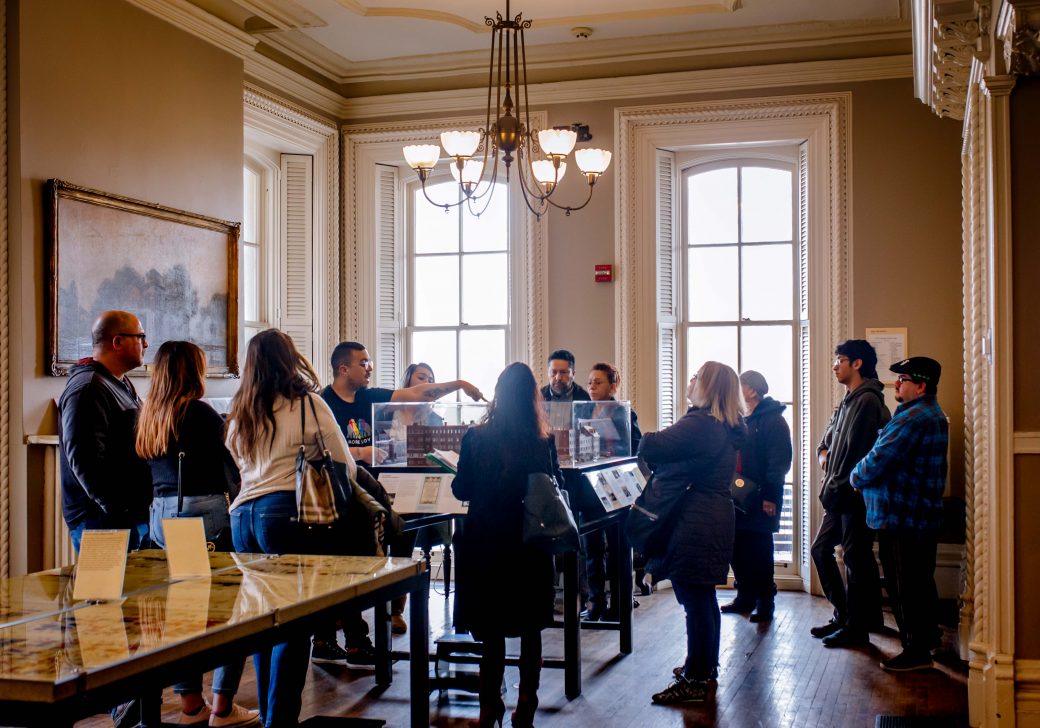Table Of Content
- Chicago Hauntings: Ghosts, A Portal, And A Devil Baby At Jane Addams' Hull House
- Museums Dedicated to Extraordinary Women
- Futaba Cake Building
- Jane Addams Hull-House Museum
- ( 413-5353 jahh@uic.edu800 S. Halsted Street (M/C Chicago, IL 60607-7017Privacy Policy
- Hull House neighborhood
- A Life-Changing Journey

As a scholar of heroism and a former teacher of secondary-school students, I am always looking for exemplary lives. Jane absorbed Thomas Carlyle’s On Heroes and Hero Worship and revered Jo in Little Women. I think of Jane Addams as a hero—a woman of extraordinary achievement, courage, and greatness of soul. I see a role model for today’s youth caught up in a celebrity entertainment culture like the youthful immigrants of the early twentieth century who haunted saloons and movie houses described in Addams’s book The Spirit of Youth and the City Streets. Never repenting her pacifism, Addams spent the last half of her life denouncing war in impassioned speeches and in subtle, convincing articles that gained in relevance as the Great War increasingly seemed futile. Whether her opposition to militarism would have remained steadfast with the challenge of Franco, Mussolini, Hitler, and Stalin will never be known.
Chicago Hauntings: Ghosts, A Portal, And A Devil Baby At Jane Addams' Hull House

In 1889, Jane Addams, an idealistic college graduate, rented a run-down mansion on a derelict strip of Halsted Street in Chicago’s Nineteenth Ward. The neighborhood was home to thousands of recently arrived immigrants—Italians, Greeks, Russian Jews, Bohemians, and Irish. Addams, like many young people, was searching for purpose and meaning. Her plan was to use the mansion to improve the lives of the urban poor.
Museums Dedicated to Extraordinary Women
Other critics claim Addams was overly optimistic, lacking a “tragic view” of life. Knight disagrees, citing Addams’s unsentimental realism and reminding us that she was very familiar with death and suffering. Among Addams’s books are Democracy and Social Ethics (1902), Newer Ideals of Peace (1907), Twenty Years at Hull-House (1910), and The Second Twenty Years at Hull-House (1930).
Futaba Cake Building
Addams also served as the first female president of the National Conference of Social Work, established the National Federation of Settlements and served as president of the Women's International League for Peace and Freedom. Among the facilities at Hull House were a day nursery, a gymnasium, a community kitchen, and a boarding club for working girls. Hull House offered college-level courses in various subjects, furnished training in art, music, and crafts such as bookbinding, and sponsored one of the earliest little-theatre groups, the Hull House Players. In addition to making available services and cultural opportunities for the largely immigrant population of the neighbourhood, Hull House afforded an opportunity for young social workers to acquire training. Jane Addams (born September 6, 1860, Cedarville, Illinois, U.S.—died May 21, 1935, Chicago, Illinois) was an American social reformer and pacifist, co-winner (with Nicholas Murray Butler) of the Nobel Prize for Peace in 1931.
Jane Addams Hull-House Museum
Thorstein Veblen eviscerated the idle rich and coined the phrase “conspicuous consumption” in The Theory of the Leisure Class. Alice Hamilton fulfilled Jane Addams’s dream by graduating, in 1893, from the University of Michigan’s medical school. Living on and off at Hull-House in the 1890s, Hamilton attempted to identify causes of typhoid and tuberculosis in the surrounding community, became an expert on lead poisoning, and went on to have an exceptional career in public health.
Hull House Association To Shut Down - CBS Chicago - CBS Chicago
Hull House Association To Shut Down - CBS Chicago.
Posted: Thu, 19 Jan 2012 08:00:00 GMT [source]
Eventually its educational facilities provided secondary and college-level extension classes as well as evening classes on civil rights and civic duties. Through increased donations more buildings were purchased, and Hull House became a complex, containing a gymnasium, social and cooperative clubs, shops, housing for children, and playgrounds. During her trip abroad, Addams became a critical observer of society. Deeply moved by the suffering of others, and especially the indigent, Addams sought solutions to the problems faced by residents of densely packed cities. Addams returned from this trip energized to create a settlement house similar to what she’d seen in Toynbee Hall, a social settlement in London. In 1887–88 Addams returned to Europe with a Rockford classmate, Ellen Gates Starr.
What began as an exploration of the sights and cultures of Europe became, in fact, an eye-opening experience for Addams. The trip ended in tragedy when John Addams became gravely ill and died suddenly of appendicitis. A grieving Jane Addams, seeking direction in her life, applied to the Women's Medical College of Philadelphia, where she was accepted for the fall of 1881. Many of her classmates went on to become missionaries, but Jane Addams believed that she could find a way of serving mankind without promoting Christianity.
Hull House neighborhood
Addams referred to their relationship, which lasted 37 years, as a “marriage.” She destroyed many of Smith’s letters. In our less reticent age, skeptical of affectionate female friendships, there is speculation among historians about their relationship. Addams was friendly with and consulted by progressive presidents Theodore Roosevelt and Woodrow Wilson, who supported regulating corporations, protecting consumers, improving the environment, and legitimizing unions. Julia Lathrop, whom Addams had met at the Rockford Female Seminary, organized a discussion group, the Plato Club.
In her autobiography, 20 Years at Hull-House (1910), she argued that society should both respect the values and traditions of immigrants and help the newcomers adjust to American institutions. A new social ethic was needed, she said, to stem social conflict and address the problems of urban life and industrial capitalism. Although tolerant of other ideas and social philosophies, Addams believed in Christian morality and the virtue of learning by doing.

The museum commemorates the work of the Hull-House Settlement, the lives of those in the neighborhood, and the continuing fight for social change that Hull-House was part of over a century ago. The work of Jane Addams and Hull House empowered both individuals and families and stirred social reform for more than 120 years. Impacting everything from women’s issues to workers’ rights, Addams and Hull House were dedicated to improving the conditions of Chicago lives.
Mrs. Addams expressed her fond hope that Jane and George would marry one day. George did have romantic feelings for Jane, but she didn't return the sentiment. Jane Addams was never known to have had a romantic relationship with any man. Jane Addams had set her sights on Smith College, a prestigious women's school in Massachusetts, with the goal of eventually earning a medical degree. After months of preparing for the difficult entrance exams, 16-year-old Jane learned in July 1877 that she'd been accepted at Smith. Jane's father ran a successful mill business, which enabled him to build a large, beautiful home for his family.
Addams insisted that Jane enroll in Rockford Female Seminary, a Presbyterian-based women's school in nearby Rockford, Illinois that her sisters had attended. Though devoted to European culture, Addams was at heart an American democrat who rejected the English class system. Mesmerized by Tolstoy, she visited him in Russia in 1896 and became a lifelong pacifist. Tolstoy, who had hundreds of visitors over the years, seemed unaware of her Chicago fame and chided her fashionable leg o’ mutton sleeves, which he found decadent.
She believed in self-discovery, self-discipline, and self-improvement. Her nephew and first biographer, James Weber Linn, pointed to her keen sense of humor. Not a prude, she believed in sex education, but criticized the hedonism of the 1920s and its fascination with Sigmund Freud.
The establishment of the Chicago campus of the University of Illinois in 1963 forced the Hull House Association to relocate its headquarters. The majority of its original buildings were demolished, but the Hull residence itself was preserved as a monument to Jane Addams. The Museum and its many vibrant programs make connections between the work of Hull-House residents and important contemporary social issues. Addams had a heart attack in 1926 and remained unwell for the rest of her life.

No comments:
Post a Comment